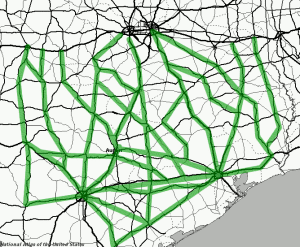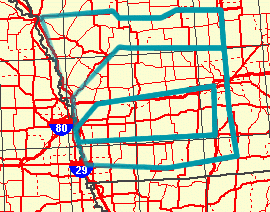Brian Gongol
The evacuations of New Orleans and Houston in advance of Hurricanes Katrina and Rita were inadequate at best and catastrophic at worst. In both major cities, hundreds of thousands of people were unable to leave despite many hours (or days) of advance warning. The roads out of New Orleans became severely congested, and Houston's evacuation went so badly that the mayor has announced the formation of a task force on evacuations to evaluate the "unacceptable" problems of the departure. This is anything but a small matter: Many of the deaths from Hurricane Rita were directly caused by the evacuation itself.
Fundamentally, an evacuation is a question of economics: How should the finite resources of a transportation system within a community be used to maximize the number of people who can use that system to reach safety?
Economist Tyler Cowen has proposed paying people to stay in the path of an anticipated storm. On one hand, that's certainly creative thinking for anticipatable events like hurricanes and may merit further consideration. But it's absolutely unworkable for unexpected events like terrorist attacks. Given the very high risk of terrorist attacks using non-conventional weapons (the Lugar Survey on Proliferation suggests that the national security community puts the 10-year chances of radiological or biological attacks in the 20% to 30% range), we need to examine exactly why the evacuations haven't worked and what needs to be done so that they will work in the future.
All of the following are observations about the failures of mass evacuations by automobile, based especially on the well-documented evacuation of Houston, which occurred with considerable advance notice of the threat from Hurricane Rita. It is assumed that future evacuations of major American cities will also be performed primarily by automobile.
Failure #1: The Bullwhip Effect
 The 100-mile traffic jam on the roads extending north from Houston was inevitable, due to the bullwhip effect. As a chain of cars accelerates and decelerates, the longer the chain, the greater the change in velocity at the end of the chain. This is due to the same effect as the cracking of a bullwhip; while the end near the user's wrist may only speed up and slow down a little, the opposite tip is moved through the speed of sound (thus creating the trademark "crack" of the whip). This effect has been observed in a practical test involving a chain of cars in a single-lane lineup.
The 100-mile traffic jam on the roads extending north from Houston was inevitable, due to the bullwhip effect. As a chain of cars accelerates and decelerates, the longer the chain, the greater the change in velocity at the end of the chain. This is due to the same effect as the cracking of a bullwhip; while the end near the user's wrist may only speed up and slow down a little, the opposite tip is moved through the speed of sound (thus creating the trademark "crack" of the whip). This effect has been observed in a practical test involving a chain of cars in a single-lane lineup.
Future evacuations could resolve this problem through the use of pace cars and rolling roadblocks throughout the evacuation path. These pace cars could help reduce the impact of sudden changes in velocity by building a smoother flow of traffic, rather than allowing the buildup of a conventional urban traffic jam.
Failure #2: The Chute
Very much related to the bullwhip effect is the problem of removing people from the evacuation as it is completed. The 100-mile traffic jam was created as virtually everyone in the evacuation line tried to get from Houston to Dallas. The problem is that this extreme concentration of destination meant that any problems absorbing the extra traffic north of Houston were felt all the way back through the evacuation line...creating repercussions throughout the 100-mile line. On the way to Dallas, traffic evacuating Houston via Interstate 45 passed through Huntsville, where many people trying to get to Dallas got stranded as their fuel ran out.
Future evacuations need to "overshoot" the target destination. Instead of sending people to Dallas, the evacuation should have sent them beyond Dallas, then absorbed them back into the city. The same principle is in effect at any 5k or 10k road race or cross-country run. Runners don't stop moving once they cross the finish line; they move through the "chute", which is a long lane that absorbs them in an orderly manner well past the actual destination of the finish line. The chute allows large numbers of runners to cross the finish line almost simultaneously without landing on top of one another or backing up just a few meters from the finish line. What any mass evacuation needs is a "chute" of its own -- a method of absorbing the inbound evacuees at a high rate without congesting the evacuation lanes.
Failure #3: Concentration Instead of Diffusion
 The identified evacuation routes for Houston all point north. While the logical destinations in the event of a hurricane certainly are to the north of the city, that doesn't mean the smart way to get there is by pointing all evacuees in the same direction. This is a lesson that the computer industry knows well; the Internet isn't designed to send all data in the same geographic direction, but instead spreads out the data packets at first, and then lets them re-aggregate once they reach the destination. The same principle is behind Oracle's claim that their grid server "never breaks": Instead of relying on single one-way flow of information, the array of servers adapts to handle computing requirements by distributing the load in many different directions.
The identified evacuation routes for Houston all point north. While the logical destinations in the event of a hurricane certainly are to the north of the city, that doesn't mean the smart way to get there is by pointing all evacuees in the same direction. This is a lesson that the computer industry knows well; the Internet isn't designed to send all data in the same geographic direction, but instead spreads out the data packets at first, and then lets them re-aggregate once they reach the destination. The same principle is behind Oracle's claim that their grid server "never breaks": Instead of relying on single one-way flow of information, the array of servers adapts to handle computing requirements by distributing the load in many different directions.
Future evacuations need to first disperse all of the people, then let them find their way to the destination. The Houston evacuation routes instead created a massive set of northbound bottlenecks, leaving traffic flowing at ridiculous paces as slow as just one or two miles per hour. Instead, Houstonians should have been scattered in all available directions at first -- northeast, north, northwest, west, and southwest -- then directed northward. Other mass evacuations must do the same whenever possible -- diffusing the people out before their concentration threatens the evacuation itself. Even an extra hour or two of travel in a direction other than north could have moved lots of people out of the city faster.
Failure #4: Dependence on Multi-Lane Roads
In response to the Houston evacuation, many people will certainly call for more and wider express highway routes out of the city. Yet Houston is already one of the most highway-heavy cities in the country. An increased dependence on a small number of arterial evacuation routes won't make future evacuations better. Part of the trouble with multi-lane expressways is that they limit the number of available alternatives when something goes wrong. Many of the vehicles leaving Houston ran out of gas, and any vehicle that becomes an obstruction makes for serious trouble on a controlled-access roadway like an Interstate highway.
Future evacuations must use smaller highways and two-lane roads as primary modes of evacuation, just as much as they employ expressways. The worst backup that ever emerges on a two-lane road is caused by a slow-moving vehicle, like a tractor. But on a two-lane highway, a tractor can pull over to the side of the road or onto a secondary road, even if only temporarily, in order to let the other vehicles pass. By comparison, a stranded vehicle on an expressway creates a choke point. A well-organized evacuation must include the use of all roads out of a city, including secondary highways and smaller-capacity roads. A two-lane highway can have its opposing lane temporarily reversed and serve about as much traffic as a conventional two-lane expressway -- but only if the authorities are innovative enough to apply such a practice. An investment in better secondary highways (possibly including timed stoplights or better on-the-scene police guidance) would probably be much more efficient and effective at improving emergency evacuations than simply adding more lanes to existing arterial routes.
Illustration: Using Secondary Highways

Suppose the city of Des Moines, IA were evacuated, with a destination of Omaha, NE. Interstate 80 is a four-lane expressway linking the two cities. But concentrating the entire evacuation on I-80 would inevitably lead to the kind of congestion experienced in Houston.

Clearly, the use of alternative routes, including the many two-lane highways running east-west between Des Moines and Omaha significantly increases the potential volume of traffic that could be moved out of the city. If even a few two-lane highways were used, they could rapidly equal the capacity of the Interstate route, and temporary lane reversal could increase this capacity even more. This further illustrates the value of diffusing traffic rather than concentrating it (as identified in Failure #3), as only a small amount of travel at a right-angle to the evacuation can significantly increase the potential capacity of the evacuation routes.
